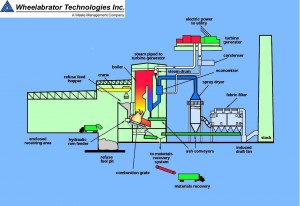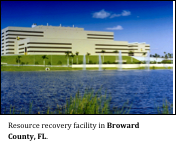Waste-to-Energy (also Energy from Waste, or EfW)
What is WTE?
WTE generally refers to mass burn, and refuse derived fuel combustors that recover energy from municipal solid waste. The schematic figure shows one example. The growth of modern WTE in the US began in the late 1980s. Many similar technologies have been growing or emerging over the last ten years that are sometimes referred to as WTE. Examples include recovery of landfill methane gas (LFG) from
landfills (LFG-to-Energy), and emerging conversion technologies such as plasma arc gasification, pyrolysis, chemical conversion to ethanol and others. A critical distinction between WTE and LFG-to Energy is that WTE is a commercially proven processing method that recovers energy and produces residue. LFG-to-Energy, also commercially proven recovers energy from existing disposal facilities.
While these emerging processing and disposal technologies are anticipated to recover energy, commercially viable examples are still in the developmental stage.
Value Added Consulting, LLC’s president, Sandy Gutner has extensive experience in virtually every aspect of the highly specialized area of Energy from Waste (EfW). Prior to forming Value Added Consulting, Mr. Gutner has been employed by nationally recognized Architect/Engineering firms for more than 22 years, and has provided consulting services at 15 large scale EfW facilities with a combined total processing capacity of more than 21,500 tons per day of Municipal Solid Waste (MSW).
Waste-to-Energy Services:
- Feasibility study
- Procurement
- Contract development and negotiation
- Capital improvement
- Contract administration
- Performance testing
- Ash residue sampling and testing
| Project | Capacity (tons per day) |
| Broward County Waste and Recycling Services, FL | (2) x 2,250 |
| Palm Beach County Solid Waste Authority, FL | 2,000 |
| City of Tampa, FL | 1,000 |
| Lake County, FL | 525 |
| Miami-Dade Dep’t of Solid Waste | 3,000 |
| Bristol Resource Recovery Operating Committee, CT | 520 |
| Union County, NJ | 1440 |
| Lee County, FL | 1440 |
| Fairfax County, VA | 3,000 |
| Bay County, FL | 500 |
| Islip, NY | 525 |
| R-II Builders, Manilla | 3,000 |
| Dutchess County Resource Recovery Agency, NY | 520 |
| Monmouth County, NJ | 1,700 |
Waste-to-Energy and the Environment
Waste-to-Energy creates many environmental benefits, including offsetting the use of oil, more efficient use of land, reduced Greenhouse Gas (GHG) emissions. The largest component of air emissions from WTE is Carbon Dioxide, with a global warming factor of 1. In comparison, methane, the most common gas emission from landfills ha a global warming factor of 30. It has also been widely documented that communities where WTE facilities exist tend to have a greater level of recycling. A 2009 report by Governmental Advisory Associates further confirms this trend. Read Recycling and Waste-to-Energy: Are They Compatible? 2009 Update



